key MITSUBISHI SHOGUN 2017 (in English) Owner's Guide
[x] Cancel search | Manufacturer: MITSUBISHI, Model Year: 2017, Model line: SHOGUN, Model: MITSUBISHI SHOGUN 2017Pages: 394, PDF Size: 19 MB
Page 144 of 394
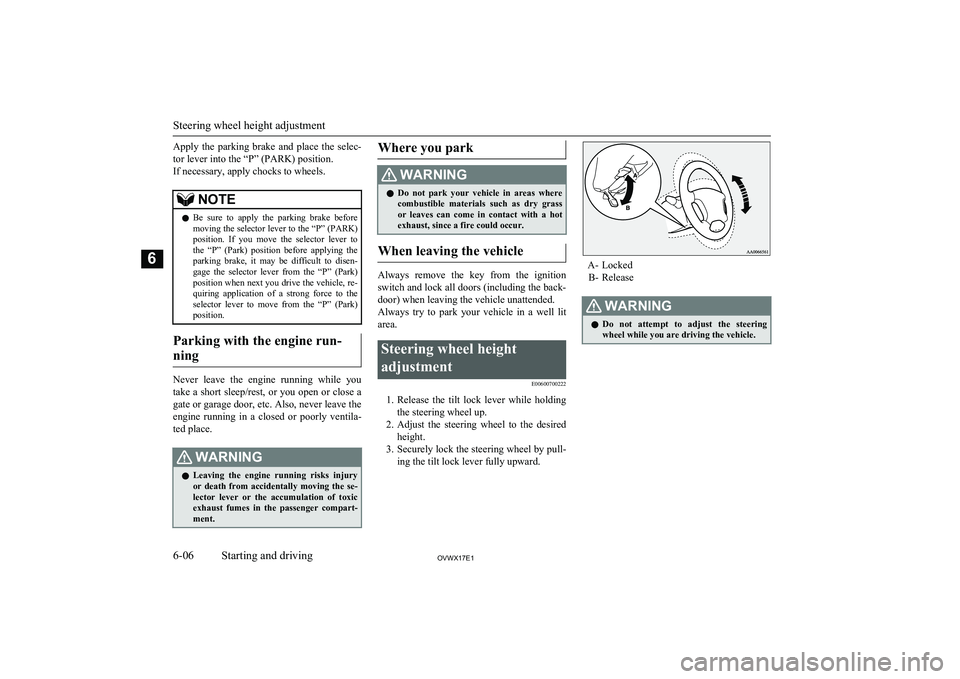
Apply the parking brake and place the selec-tor lever into the “P” (PARK) position.
If necessary, apply chocks to wheels.NOTEl Be sure to apply the parking brake before
moving the selector lever to the “P” (PARK)
position. If you move the selector lever to the “P” (Park) position before applying the
parking brake, it may be difficult to disen-
gage the selector lever from the “P” (Park) position when next you drive the vehicle, re-quiring application of a strong force to the
selector lever to move from the “P” (Park) position.
Parking with the engine run-
ning
Never leave the engine running while you
take a short sleep/rest, or you open or close a gate or garage door, etc. Also, never leave the
engine running in a closed or poorly ventila-
ted place.
WARNINGl Leaving the engine running risks injury
or death from accidentally moving the se- lector lever or the accumulation of toxic
exhaust fumes in the passenger compart-
ment.Where you parkWARNINGl Do not park your vehicle in areas where
combustible materials such as dry grass
or leaves can come in contact with a hot exhaust, since a fire could occur.
When leaving the vehicle
Always remove the key from the ignition
switch and lock all doors (including the back-
door) when leaving the vehicle unattended. Always try to park your vehicle in a well lit area.
Steering wheel height
adjustment E00600700222
1.Release the tilt lock lever while holding
the steering wheel up.
2. Adjust the steering wheel to the desired
height.
3. Securely lock the steering wheel by pull-
ing the tilt lock lever fully upward.
A- Locked
B- Release
WARNINGl Do not attempt to adjust the steering
wheel while you are driving the vehicle.
Steering wheel height adjustment
6-06OVWX17E1Starting and driving6
Page 148 of 394

NOTElBe careful not to get your hands trapped
while a mirror is moving.
l If you move a mirror by hand or it moves af-
ter hitting a person or object, you may not be
able to return it to its original position using the mirror retractor switch. If this happens,
push the mirror retractor switch to place the mirror in its retracted position and then push
the switch again to return the mirror to its original position.
l If the battery voltage is low and you start the
engine while extending the mirrors, the mir- rors may stop part-way. If this happens, push
the mirror retractor switch to retract the mir- rors and then push the switch again to extend
them.
l When freezing has occurred and mirrors fail
to operate as intended, please refrain from
repeated pushing of the retractor switch as
this action can result in burn-out of the mir- ror motor circuits.
Automatic extension of mirrors
If the engine is stopped and started with the
mirrors retracted, the mirrors automatically
extend for safety when the vehicle speed rea-
ches 30 km/h (19 mph).
Heated mirror*
E00601200312
To demist or defrost the outside rear-view
mirrors, press the rear window demister
switch.
The indication lamp (C) will illuminate while
the demister is on.
The heater will be turned off automatically in about 20 minutes.Ignition switch
E00601403399LOCK
The engine is stopped and the steering wheel
locked. The key can only be inserted and re- moved in this position.
ACC
The engine is stopped, but the electrical devi-
ces such as the radio and cigarette lighter can be operated.
ON
The engine is running, and all the vehicle’s
electrical devices can be operated.
START
The starter motor operates. After the engine has started, release the key and it will auto- matically return to the “ON” position.
NOTEl Your vehicle is equipped with an electronic
immobilizer. To start the engine, the ID codetransmitted by the transponder inside the key must match the code registered in the immo-bilizer computer.
Refer to “Electronic immobilizer” on page
3-03.
Ignition switch
6-10OVWX17E1Starting and driving6
Page 149 of 394
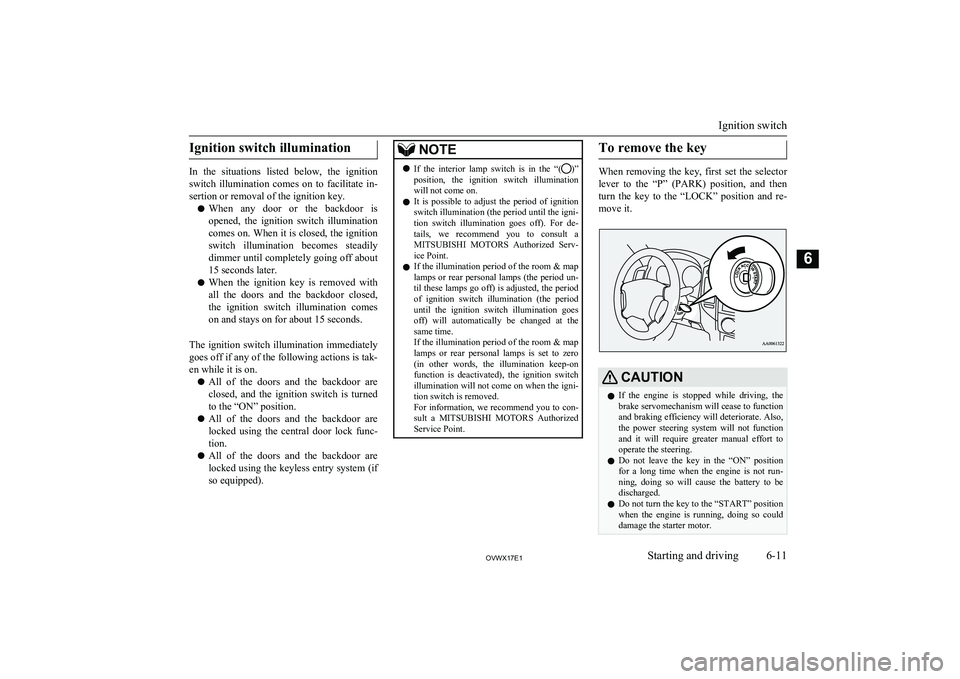
Ignition switch illumination
In the situations listed below, the ignitionswitch illumination comes on to facilitate in-
sertion or removal of the ignition key.
l When any door or the backdoor is
opened, the ignition switch illumination
comes on. When it is closed, the ignition switch illumination becomes steadily
dimmer until completely going off about 15 seconds later.
l When the ignition key is removed with
all the doors and the backdoor closed, the ignition switch illumination comes
on and stays on for about 15 seconds.
The ignition switch illumination immediately goes off if any of the following actions is tak-
en while it is on.
l All of the doors and the backdoor are
closed, and the ignition switch is turned
to the “ON” position.
l All of the doors and the backdoor are
locked using the central door lock func-
tion.
l All of the doors and the backdoor are
locked using the keyless entry system (if so equipped).
NOTEl If the interior lamp switch is in the “()”
position, the ignition switch illumination
will not come on.
l It is possible to adjust the period of ignition
switch illumination (the period until the igni-
tion switch illumination goes off). For de-
tails, we recommend you to consult a
MITSUBISHI MOTORS Authorized Serv-
ice Point.
l If the illumination period of the room & map
lamps or rear personal lamps (the period un-
til these lamps go off) is adjusted, the period
of ignition switch illumination (the period until the ignition switch illumination goes
off) will automatically be changed at the same time.
If the illumination period of the room & map
lamps or rear personal lamps is set to zero
(in other words, the illumination keep-on function is deactivated), the ignition switch
illumination will not come on when the igni-
tion switch is removed.
For information, we recommend you to con-
sult a MITSUBISHI MOTORS Authorized
Service Point.To remove the key
When removing the key, first set the selector
lever to the “P” (PARK) position, and thenturn the key to the “LOCK” position and re-
move it.
CAUTIONl If the engine is stopped while driving, the
brake servomechanism will cease to function and braking efficiency will deteriorate. Also,
the power steering system will not function
and it will require greater manual effort to
operate the steering.
l Do not leave the key in the “ON” position
for a long time when the engine is not run- ning, doing so will cause the battery to bedischarged.
l Do not turn the key to the “START” position
when the engine is running, doing so could damage the starter motor.
Ignition switch
6-11OVWX17E1Starting and driving6
Page 150 of 394
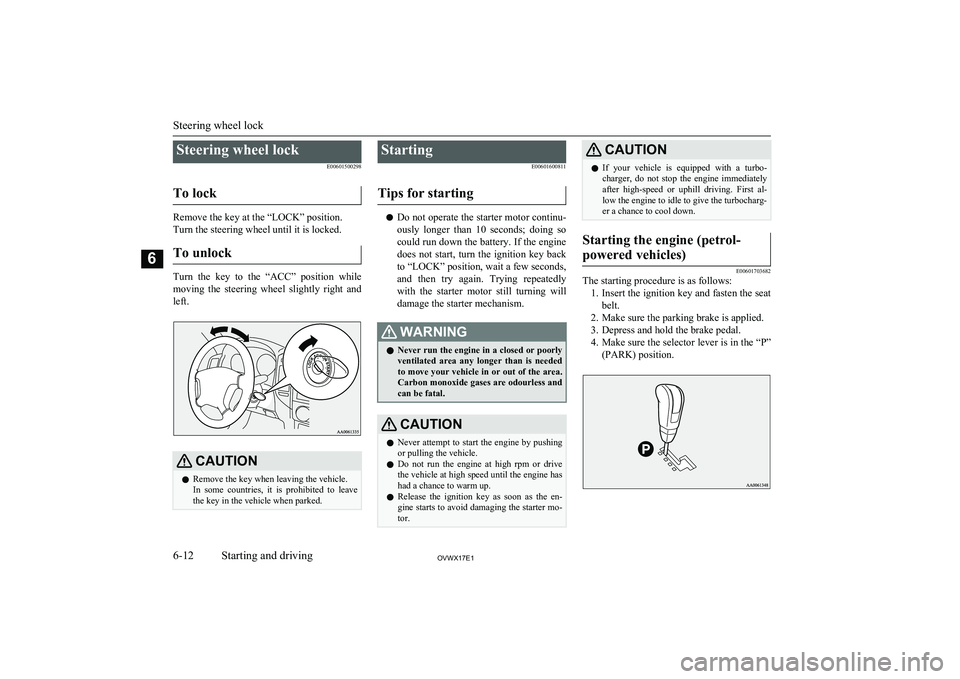
Steering wheel lockE00601500298
To lock
Remove the key at the “LOCK” position.
Turn the steering wheel until it is locked.
To unlock
Turn the key to the “ACC” position while
moving the steering wheel slightly right and left.
CAUTIONl Remove the key when leaving the vehicle.
In some countries, it is prohibited to leave the key in the vehicle when parked.Starting
E00601600811
Tips for starting
l Do not operate the starter motor continu-
ously longer than 10 seconds; doing so
could run down the battery. If the engine
does not start, turn the ignition key back to “LOCK” position, wait a few seconds,and then try again. Trying repeatedly with the starter motor still turning will
damage the starter mechanism.
WARNINGl Never run the engine in a closed or poorly
ventilated area any longer than is needed to move your vehicle in or out of the area.Carbon monoxide gases are odourless and
can be fatal.CAUTIONl Never attempt to start the engine by pushing
or pulling the vehicle.
l Do not run the engine at high rpm or drive
the vehicle at high speed until the engine has had a chance to warm up.
l Release the ignition key as soon as the en-
gine starts to avoid damaging the starter mo-
tor.CAUTIONl If your vehicle is equipped with a turbo-
charger, do not stop the engine immediately
after high-speed or uphill driving. First al-
low the engine to idle to give the turbocharg-
er a chance to cool down.Starting the engine (petrol-
powered vehicles)
E00601703682
The starting procedure is as follows: 1. Insert the ignition key and fasten the seat
belt.
2. Make sure the parking brake is applied.
3. Depress and hold the brake pedal.
4. Make sure the selector lever is in the “P”
(PARK) position.
Steering wheel lock
6-12OVWX17E1Starting and driving6
Page 151 of 394
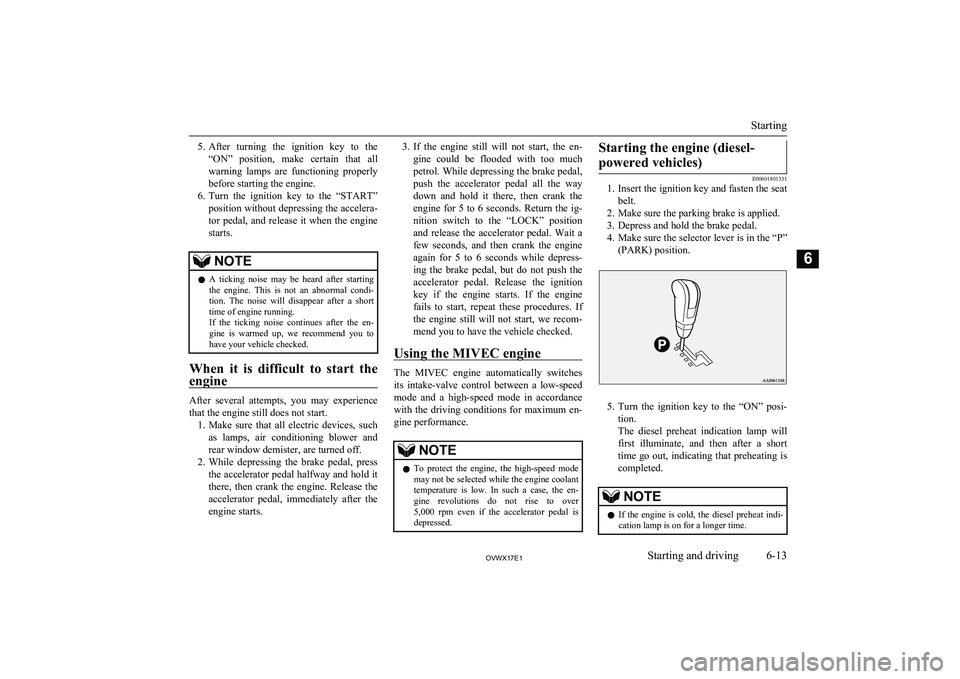
5.After turning the ignition key to the
“ON” position, make certain that all
warning lamps are functioning properly before starting the engine.
6. Turn the ignition key to the “START”
position without depressing the accelera-
tor pedal, and release it when the engine starts.NOTEl A ticking noise may be heard after starting
the engine. This is not an abnormal condi-tion. The noise will disappear after a shorttime of engine running.
If the ticking noise continues after the en-
gine is warmed up, we recommend you to have your vehicle checked.
When it is difficult to start the
engine
After several attempts, you may experience that the engine still does not start. 1. Make sure that all electric devices, such
as lamps, air conditioning blower and
rear window demister, are turned off.
2. While depressing the brake pedal, press
the accelerator pedal halfway and hold it
there, then crank the engine. Release the
accelerator pedal, immediately after the
engine starts.
3. If the engine still will not start, the en-
gine could be flooded with too much
petrol. While depressing the brake pedal, push the accelerator pedal all the way
down and hold it there, then crank the
engine for 5 to 6 seconds. Return the ig- nition switch to the “LOCK” position
and release the accelerator pedal. Wait a few seconds, and then crank the engine
again for 5 to 6 seconds while depress-
ing the brake pedal, but do not push the accelerator pedal. Release the ignition
key if the engine starts. If the engine
fails to start, repeat these procedures. If the engine still will not start, we recom-
mend you to have the vehicle checked.
Using the MIVEC engine
The MIVEC engine automatically switches its intake-valve control between a low-speed mode and a high-speed mode in accordancewith the driving conditions for maximum en-
gine performance.
NOTEl To protect the engine, the high-speed mode
may not be selected while the engine coolanttemperature is low. In such a case, the en-
gine revolutions do not rise to over
5,000 rpm even if the accelerator pedal is depressed.Starting the engine (diesel-
powered vehicles)
E00601801331
1. Insert the ignition key and fasten the seat
belt.
2. Make sure the parking brake is applied.
3. Depress and hold the brake pedal.
4. Make sure the selector lever is in the “P”
(PARK) position.
5. Turn the ignition key to the “ON” posi-
tion.
The diesel preheat indication lamp will
first illuminate, and then after a short
time go out, indicating that preheating is completed.
NOTEl If the engine is cold, the diesel preheat indi-
cation lamp is on for a longer time.
Starting
6-13OVWX17E1Starting and driving6
Page 152 of 394
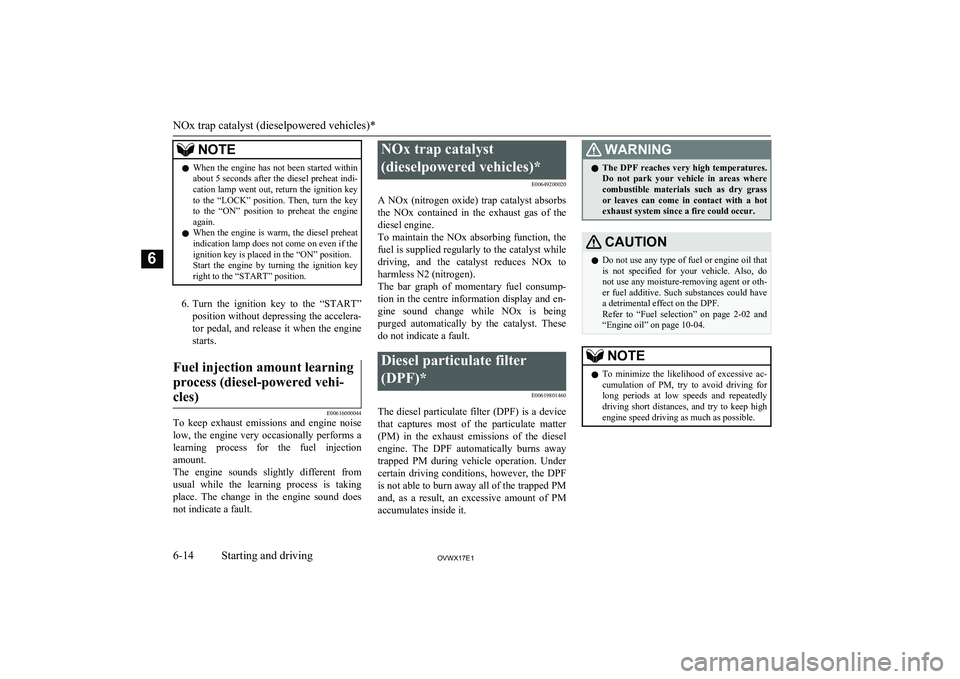
NOTElWhen the engine has not been started within
about 5 seconds after the diesel preheat indi-
cation lamp went out, return the ignition key to the “LOCK” position. Then, turn the key
to the “ON” position to preheat the engine
again.
l When the engine is warm, the diesel preheat
indication lamp does not come on even if the
ignition key is placed in the “ON” position. Start the engine by turning the ignition key
right to the “START” position.
6. Turn the ignition key to the “START”
position without depressing the accelera- tor pedal, and release it when the engine
starts.
Fuel injection amount learning
process (diesel-powered vehi-cles)
E00616000044
To keep exhaust emissions and engine noise low, the engine very occasionally performs a
learning process for the fuel injection
amount.
The engine sounds slightly different from
usual while the learning process is taking place. The change in the engine sound does
not indicate a fault.
NOx trap catalyst
(dieselpowered vehicles)* E00649200020
A NOx (nitrogen oxide) trap catalyst absorbs
the NOx contained in the exhaust gas of the diesel engine.
To maintain the NOx absorbing function, the
fuel is supplied regularly to the catalyst while
driving, and the catalyst reduces NOx to harmless N2 (nitrogen).
The bar graph of momentary fuel consump-
tion in the centre information display and en- gine sound change while NOx is being
purged automatically by the catalyst. These
do not indicate a fault.Diesel particulate filter
(DPF)* E00619801460
The diesel particulate filter (DPF) is a devicethat captures most of the particulate matter
(PM) in the exhaust emissions of the diesel
engine. The DPF automatically burns away trapped PM during vehicle operation. Under
certain driving conditions, however, the DPF is not able to burn away all of the trapped PM
and, as a result, an excessive amount of PM accumulates inside it.
WARNINGl The DPF reaches very high temperatures.
Do not park your vehicle in areas where
combustible materials such as dry grass
or leaves can come in contact with a hot exhaust system since a fire could occur.CAUTIONl Do not use any type of fuel or engine oil that
is not specified for your vehicle. Also, do not use any moisture-removing agent or oth-
er fuel additive. Such substances could have a detrimental effect on the DPF.
Refer to “Fuel selection” on page 2-02 and
“Engine oil” on page 10-04.NOTEl To minimize the likelihood of excessive ac-
cumulation of PM, try to avoid driving for long periods at low speeds and repeatedly
driving short distances, and try to keep high
engine speed driving as much as possible.
NOx trap catalyst (dieselpowered vehicles)*
6-14OVWX17E1Starting and driving6
Page 159 of 394
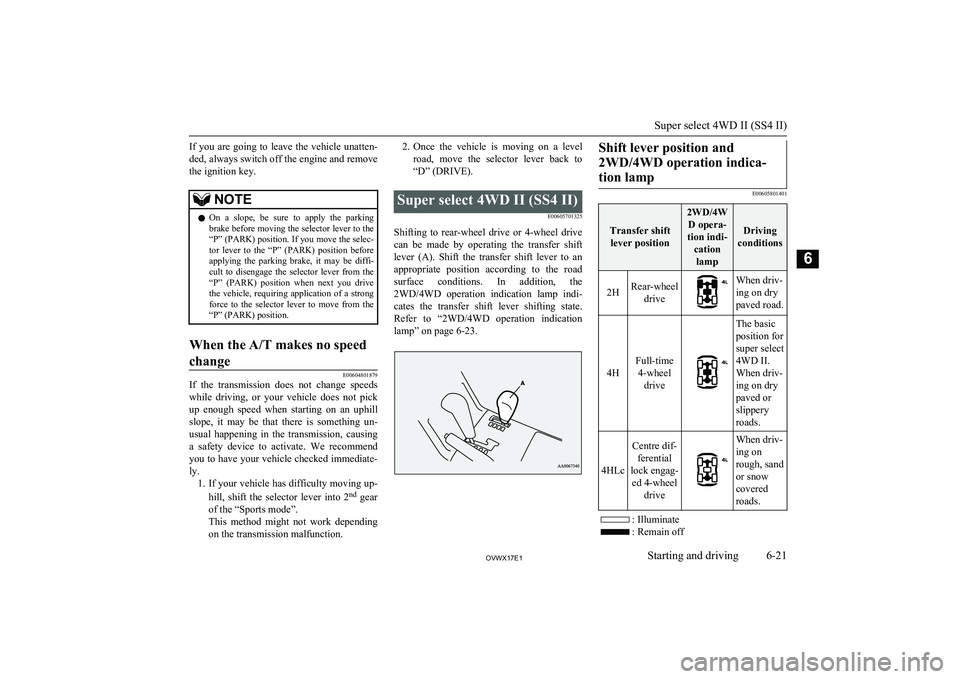
If you are going to leave the vehicle unatten-
ded, always switch off the engine and remove the ignition key.NOTEl On a slope, be sure to apply the parking
brake before moving the selector lever to the
“P” (PARK) position. If you move the selec- tor lever to the “P” (PARK) position before applying the parking brake, it may be diffi-
cult to disengage the selector lever from the
“P” (PARK) position when next you drive the vehicle, requiring application of a strong
force to the selector lever to move from the
“P” (PARK) position.When the A/T makes no speed
change
E00604801879
If the transmission does not change speeds
while driving, or your vehicle does not pick up enough speed when starting on an uphillslope, it may be that there is something un-
usual happening in the transmission, causing a safety device to activate. We recommendyou to have your vehicle checked immediate-
ly. 1. If your vehicle has difficulty moving up-
hill, shift the selector lever into 2nd
gear
of the “Sports mode”.
This method might not work depending on the transmission malfunction.
2. Once the vehicle is moving on a level
road, move the selector lever back to
“D” (DRIVE).Super select 4WD II (SS4 II)
E00605701325
Shifting to rear-wheel drive or 4-wheel drive
can be made by operating the transfer shift lever (A). Shift the transfer shift lever to an appropriate position according to the roadsurface conditions. In addition, the
2WD/4WD operation indication lamp indi- cates the transfer shift lever shifting state.Refer to “2WD/4WD operation indicationlamp” on page 6-23.
Shift lever position and
2WD/4WD operation indica- tion lamp
E00605801401
Transfer shift lever position
2WD/4W D opera-
tion indi- cationlamp
Driving
conditions2HRear-wheel driveWhen driv-
ing on dry
paved road.
4H
Full-time 4-wheel drive
The basic
position for
super select
4WD II.
When driv-
ing on dry
paved or
slippery
roads.
4HLc
Centre dif- ferential
lock engag- ed 4-wheel driveWhen driv-
ing on
rough, sand
or snow
covered
roads.
: Illuminate
: Remain off
Super select 4WD II (SS4 II)
6-21OVWX17E1Starting and driving6
Page 203 of 394
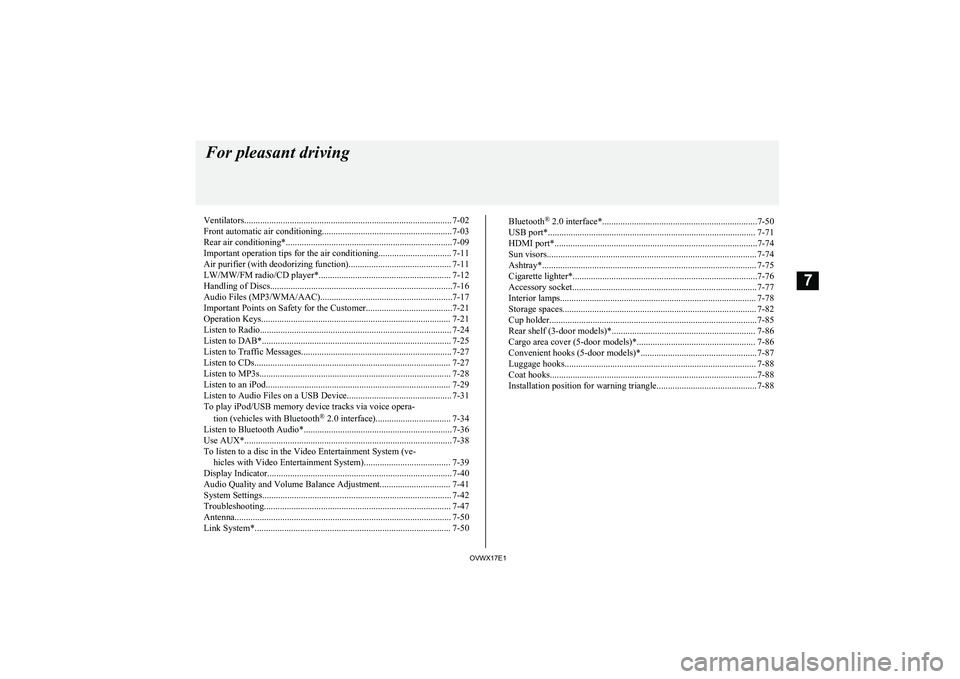
Ventilators........................................................................................... 7-02
Front automatic air conditioning......................................................... 7-03
Rear air conditioning*.........................................................................7-09
Important operation tips for the air conditioning................................ 7-11 Air purifier (with deodorizing function)............................................. 7-11
LW/MW/FM radio/CD player*.......................................................... 7-12
Handling of Discs................................................................................7-16
Audio Files (MP3/WMA/AAC)..........................................................7-17
Important Points on Safety for the Customer......................................7-21
Operation Keys................................................................................... 7-21 Listen to Radio.................................................................................... 7-24Listen to DAB*................................................................................... 7-25
Listen to Traffic Messages.................................................................. 7-27
Listen to CDs...................................................................................... 7-27
Listen to MP3s.................................................................................... 7-28
Listen to an iPod................................................................................. 7-29 Listen to Audio Files on a USB Device.............................................. 7-31To play iPod/USB memory device tracks via voice opera-
tion (vehicles with Bluetooth ®
2.0 interface)................................. 7-34
Listen to Bluetooth Audio*................................................................. 7-36
Use AUX*........................................................................................... 7-38
To listen to a disc in the Video Entertainment System (ve- hicles with Video Entertainment System)...................................... 7-39
Display Indicator................................................................................. 7-40
Audio Quality and Volume Balance Adjustment............................... 7-41
System Settings................................................................................... 7-42
Troubleshooting.................................................................................. 7-47
Antenna............................................................................................... 7-50
Link System*...................................................................................... 7-50Bluetooth ®
2.0 interface*....................................................................7-50
USB port*........................................................................................... 7-71
HDMI port*.........................................................................................7-74 Sun visors............................................................................................ 7-74
Ashtray*.............................................................................................. 7-75 Cigarette lighter*.................................................................................7-76
Accessory socket................................................................................. 7-77
Interior lamps...................................................................................... 7-78 Storage spaces..................................................................................... 7-82
Cup holder........................................................................................... 7-85 Rear shelf (3-door models)*............................................................... 7-86
Cargo area cover (5-door models)*.................................................... 7-86
Convenient hooks (5-door models)*................................................... 7-87
Luggage hooks.................................................................................... 7-88 Coat hooks...........................................................................................7-88
Installation position for warning triangle............................................ 7-88For pleasant driving
OVWX17E17
Page 223 of 394
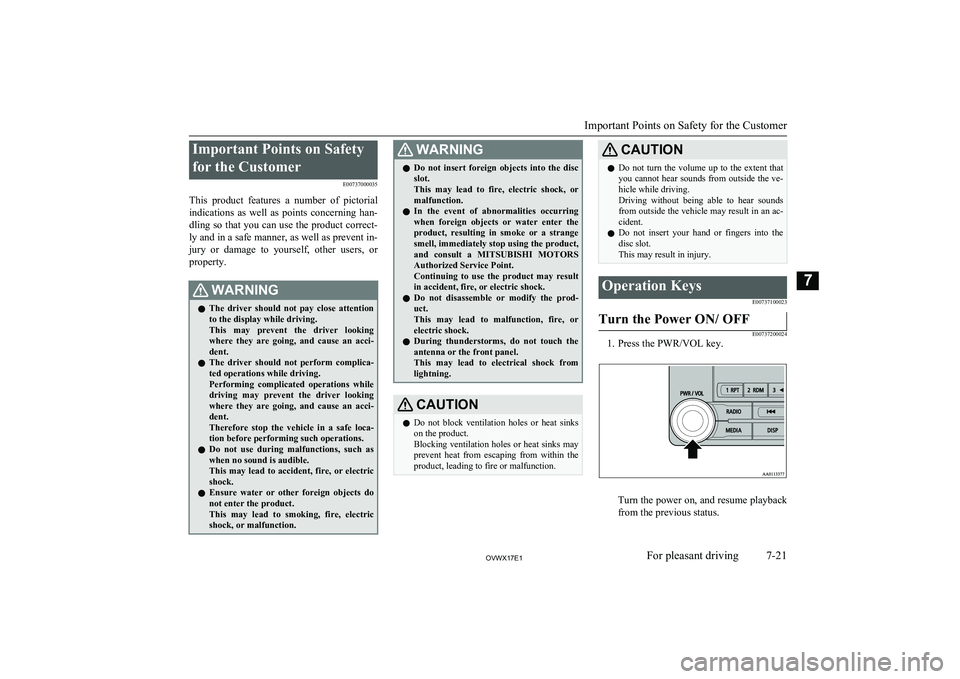
Important Points on Safetyfor the Customer E00737000035
This product features a number of pictorial indications as well as points concerning han-
dling so that you can use the product correct-
ly and in a safe manner, as well as prevent in-
jury or damage to yourself, other users, or
property.WARNINGl The driver should not pay close attention
to the display while driving.
This may prevent the driver looking where they are going, and cause an acci-
dent.
l The driver should not perform complica-
ted operations while driving.
Performing complicated operations while driving may prevent the driver looking
where they are going, and cause an acci- dent.
Therefore stop the vehicle in a safe loca- tion before performing such operations.
l Do not use during malfunctions, such as
when no sound is audible.
This may lead to accident, fire, or electric shock.
l Ensure water or other foreign objects do
not enter the product.
This may lead to smoking, fire, electric shock, or malfunction.WARNINGl Do not insert foreign objects into the disc
slot.
This may lead to fire, electric shock, or malfunction.
l In the event of abnormalities occurring
when foreign objects or water enter the
product, resulting in smoke or a strange
smell, immediately stop using the product, and consult a MITSUBISHI MOTORS
Authorized Service Point.
Continuing to use the product may result in accident, fire, or electric shock.
l Do not disassemble or modify the prod-
uct.
This may lead to malfunction, fire, or
electric shock.
l During thunderstorms, do not touch the
antenna or the front panel.
This may lead to electrical shock from lightning.CAUTIONl Do not block ventilation holes or heat sinks
on the product.
Blocking ventilation holes or heat sinks may prevent heat from escaping from within theproduct, leading to fire or malfunction.CAUTIONl Do not turn the volume up to the extent that
you cannot hear sounds from outside the ve-
hicle while driving.
Driving without being able to hear sounds from outside the vehicle may result in an ac-
cident.
l Do not insert your hand or fingers into the
disc slot.
This may result in injury.Operation Keys
E00737100023Turn the Power ON/ OFF
E00737200024
1. Press the PWR/VOL key.
Turn the power on, and resume playback
from the previous status.
Important Points on Safety for the Customer
7-21OVWX17E1For pleasant driving7
Page 224 of 394
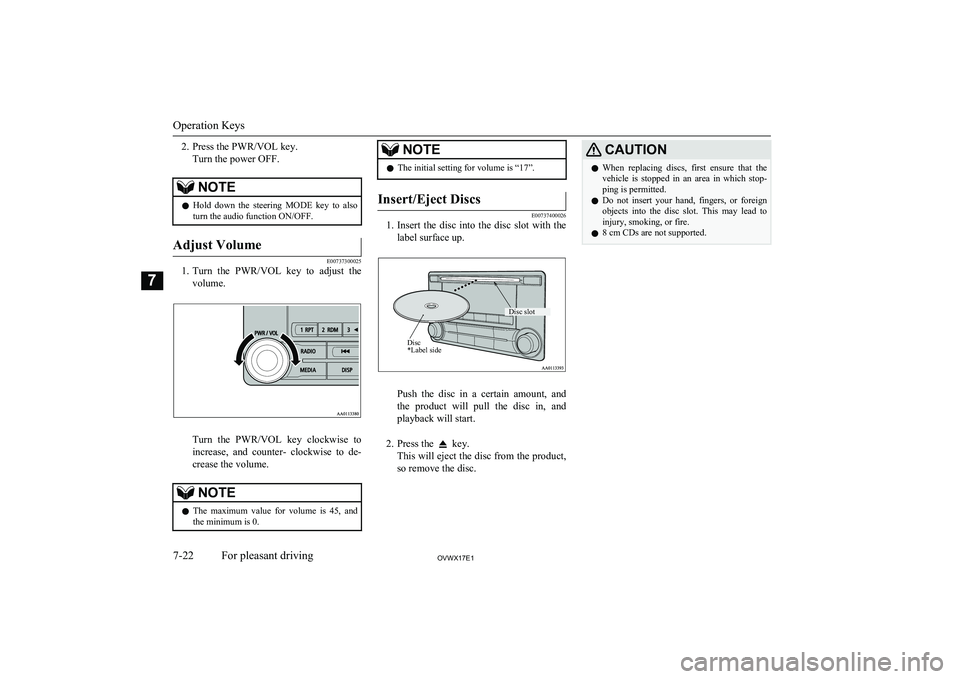
2. Press the PWR/VOL key.Turn the power OFF.NOTEl Hold down the steering MODE key to also
turn the audio function ON/OFF.Adjust Volume
E00737300025
1. Turn the PWR/VOL key to adjust the
volume.
Turn the PWR/VOL key clockwise toincrease, and counter- clockwise to de-
crease the volume.
NOTEl The maximum value for volume is 45, and
the minimum is 0.NOTEl The initial setting for volume is “17”.Insert/Eject Discs
E00737400026
1.
Insert the disc into the disc slot with the
label surface up.
Push the disc in a certain amount, and
the product will pull the disc in, and playback will start.
2. Press the
key.
This will eject the disc from the product,
so remove the disc.
CAUTIONl When replacing discs, first ensure that the
vehicle is stopped in an area in which stop-ping is permitted.
l Do not insert your hand, fingers, or foreign
objects into the disc slot. This may lead to injury, smoking, or fire.
l 8 cm CDs are not supported.
Operation Keys
7-22OVWX17E1For pleasant driving7 Disc *Label sideDisc slot